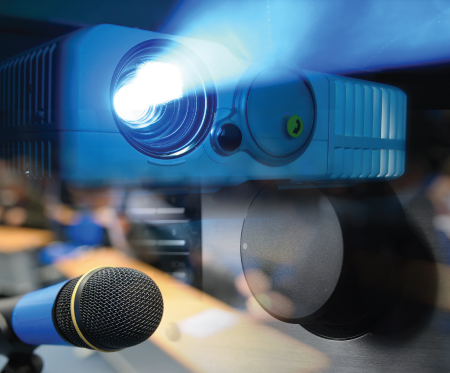The mistakes to avoid when working with audio visual charlotte nc
Wiki Article
Comprehending the Inclusion of Audio Visual Technology in Today's Educational Environments
The assimilation of audio-visual modern technology in academic setups has actually transformed the mentor and learning process. Educators currently have accessibility to devices that cater to various finding out designs, enhancing pupil engagement and partnership. However, the unification of these modern technologies presents both possibilities and challenges. Understanding exactly how to successfully carry out these devices is necessary. What approaches can educators employ to maximize the benefits of audio-visual technology in their classrooms?The Development of Audio-Visual Modern Technology in Education And Learning
As academic demands progressed over the decades, audio-visual innovation underwent substantial improvements that improved the learning atmosphere. At first, devices such as movie projectors and slide shows were the key ways of incorporating visual components into class. These very early modern technologies supplied instructors with the capacity to present information dynamically, yet they were restricted in availability and interactivity.With the arrival of video clip cassette recorders in the 1970s, classrooms started to include documented lessons, broadening the scope of instructional sources. The introduction of computers in the 1980s further reinvented this landscape, enabling the creation of multimedia discussions and interactive understanding experiences.
The rise of the internet in the 1990s noted a zero hour, allowing real-time accessibility to a wide range of audio-visual products. Today, electronic tools such as interactive whiteboards and on the internet understanding platforms continue to boost the academic experience, cultivating engagement and collaboration among learners.
Advantages of Audio-Visual Tools for Diverse Knowing Styles
Audio-visual devices play a crucial duty in satisfying diverse discovering designs by improving visual understanding and improving auditory interaction. By integrating images, video clips, and audio, these innovations create an even more inclusive educational environment. This complex technique enables instructors to resolve the diverse preferences and needs of students effectively.Enhancing Visual Knowing
Engagement in the learning procedure is substantially boosted via using audio-visual devices, satisfying various discovering designs. These tools, such as video clips, infographics, and interactive discussions, provide aesthetic stimuli that aid comprehension and retention. Aesthetic learners, in certain, gain from the unification of photos and computer animations, which can simplify complicated principles and enhance understanding. Furthermore, audio-visual resources can highlight real-world applications, making finding out a lot more appropriate and engaging. By incorporating shade, movement, and sound, instructors can produce a dynamic learning setting that records students' focus and promotes deeper cognitive links. Inevitably, the tactical usage of audio-visual modern technology not only sustains visual understanding but additionally enhances the overall academic experience for diverse learners.Improving Auditory Interaction
A significant benefit of incorporating audio-visual tools in education and learning is their capability to boost acoustic interaction amongst trainees. These tools, which incorporate multimedia discussions, podcasts, and interactive audio aspects, satisfy various discovering designs, particularly benefiting auditory learners (audio visual charlotte nc). By integrating audio and narrative, instructors can create immersive experiences that record students' focus and reinforce comprehension. This involvement is important, as it promotes a deeper understanding of the material and advertises retention. In addition, audio-visual devices can help with joint learning atmospheres, encouraging trainees to take part in conversations and share their understandings. Ultimately, the consolidation of audio-visual technology not only sustains auditory engagement but additionally enriches the overall instructional experience, making discovering more vibrant and efficient for all pupilsEnhancing Involvement Via Interactive Knowing

Additionally, gamification components, such as tests and simulations, can boost motivation and retention, making discovering more enjoyable and efficient. These approaches not just boost cognitive engagement however additionally cater to varied understanding designs, making sure that all pupils can take part meaningfully. Consequently, interactive understanding atmospheres foster a feeling of community and belonging, eventually bring about enhanced scholastic results. Via the combination of audio aesthetic technology, instructors can change traditional class right into dynamic rooms where students grow and proactively shape their instructional journeys.
Connecting Concept and Experiment Multimedia Resources
Multimedia resources work as a critical link between theoretical ideas and useful application in educational setups. By enhancing engagement, facilitating collaborative learning experiences, and supporting diverse discovering designs, these devices develop a more inclusive and dynamic discovering setting - audio visual charlotte nc. This approach not only cultivates much deeper understanding however likewise prepares students for real-world challenges
Enhancing Interaction With Multimedia
Interaction in academic setups significantly boosts when trainers integrate multimedia sources right into their teaching strategies. Making use of video clips, podcasts, and interactive discussions improves the learning experience, enabling pupils to get in touch with the product on several levels. Multimedia sources provide to numerous discovering designs, supplying visual, auditory, and kinesthetic stimulations that can hold trainees' attention better than standard lecture techniques. In addition, these resources can streamline intricate principles, making them much more available and memorable. By integrating you could look here multimedia, educators can create a dynamic class environment that promotes curiosity and encourages learners. Ultimately, the strategic use audio-visual modern technology serves to bridge the gap in between theoretical expertise and practical application, improving the academic experience for both trainers and trainees.Helping With Collaborative Learning Experiences
Countless research studies indicate that joint learning experiences markedly boost pupil outcomes when integrated with multimedia sources. Multimedia tools help with communication amongst students, permitting them to take part in analytic and vital believing collectively. By using video clip conferencing, joint systems, and interactive presentations, teachers produce atmospheres for synergy and shared understanding. These innovations enable pupils to connect their concepts successfully and obtain instant responses, cultivating a much deeper understanding of the subject matter. In addition, multimedia resources can present complicated concepts in more digestible formats, advertising conversation and cooperation. Because of this, the mix of collaborative understanding and audio-visual modern technology not just improves the academic experience yet additionally prepares pupils for real-world team effort dynamics, highlighting the importance of cooperation and collective understanding building and construction.Sustaining Diverse Learning Styles
While web link traditional teaching approaches commonly deal with a limited variety of finding out choices, the combination of audio-visual technology uses a more inclusive approach to education. By utilizing multimedia resources such as videos, interactive simulations, and electronic presentations, instructors can resolve numerous discovering designs, including aesthetic, auditory, and kinesthetic. This flexibility permits distinguished instruction, allowing trainees to involve with web content in means that resonate with their specific choices. In addition, audio-visual devices can promote deeper understanding by supplying multiple depictions of complicated ideas. As a result, trainees who may have problem with standard methods can find different pathways to success, cultivating a much more equitable learning setting that sustains academic success for all learners.Challenges in Applying Audio-Visual Innovation
Although audio-visual technology holds fantastic guarantee for boosting instructional experiences, its execution typically encounters significant obstacles. One primary concern is the economic problem related to investing in and preserving such tools, which can strain spending plans, particularly in underfunded organizations. Additionally, insufficient training for instructors can hinder efficient assimilation, leaving them ill-prepared to utilize the technology completely. Technical concerns, such as software program breakdowns and compatibility issues, might also disrupt lessons and irritate both teachers and pupils. Additionally, differing levels of student access to innovation outside the class can develop differences in learning opportunities. Finally, the potential for over-reliance on innovation may take away from essential teaching methods, eventually limiting the academic experience. Addressing these challenges calls for a comprehensive method, consisting of ample financing, specialist growth, and equitable access to sources, to assure that audio-visual modern technology can be leveraged efficiently in today's educational setups.Ideal Practices for Integrating Innovation in the Classroom

Additionally, promoting an interactive environment via joint tools motivates pupil involvement and involvement. Using varied audio-visual resources deals with different finding out designs, accommodating visual, auditory, and kinesthetic students. Consistently reviewing the impact of i thought about this modern technology on student learning aids educators refine their approaches and adapt to altering needs. Finally, including pupils in the selection of modern technology promotes possession and inspiration. By adhering to these ideal practices, instructors can develop a dynamic classroom atmosphere that efficiently integrates technology and enhances the educational experience for all students.
The Future of Audio-Visual Technology in Education And Learning
As class significantly welcome innovation, the landscape of audio-visual tools in education and learning remains to progress (audio visual charlotte nc). Future developments are expected to concentrate on greater interactivity and customization, permitting educators to customize finding out experiences to specific trainee requirements. Innovations such as augmented fact (AR) and online fact (VIRTUAL REALITY) will likely provide immersive learning atmospheres, enhancing pupil interaction and understanding
In addition, artificial knowledge (AI) is poised to play a substantial function in audio-visual technology by supplying real-time comments and flexible understanding paths. This combination may help instructors determine and attend to trainee obstacles much more effectively. Cloud-based systems will certainly promote much easier access to resources and partnership among pupils and instructors, no matter location.
In addition to these technical advances, specialist advancement for instructors will certainly be essential, ensuring they are outfitted to utilize these tools successfully. Overall, the future of audio-visual technology in education and learning assures to produce even more vibrant, comprehensive, and impactful learning experiences.
Frequently Asked Questions
Exactly How Can Teachers Choose the Right Audio-Visual Equipment for Their Class?
Picking appropriate audio-visual tools requires instructors to examine their instructional goals, take into consideration student requirements, examine available innovation, and seek suggestions from peers or professionals, ensuring tools properly enhance learning and engagement within their particular classroom environment.What Budget Factors to consider Are There for Implementing Audio-Visual Innovation?
Budget plan considerations for executing audio-visual technology include initial acquisition prices, upkeep expenses, training for team, and potential software licensing costs. Furthermore, lasting financial investment in updates and substitutes must also be factored right into monetary planning.Exist Certain Training Resources for Teachers on Audio-Visual Devices?
Several organizations provide training resources for educators on audio-visual devices, including online courses, workshops, and training guides. These sources aim to boost instructors' abilities and self-confidence in effectively incorporating innovation into their training methods.How Do We Determine the Effectiveness of Audio-Visual Innovation in Understanding?
Determining the efficiency of audio-visual modern technology in discovering entails assessing pupil interaction, comprehension, retention rates, and total scholastic performance. Studies, analyses, and empirical studies can give important insights into its influence on educational end results.What Prevail Misconceptions Regarding Audio-Visual Technology in Education?
Usual mistaken beliefs concerning audio-visual innovation in education and learning include the belief that it ensures involvement and learning results, along with the assumption that all trainees profit just as, neglecting private understanding preferences and needs.Report this wiki page